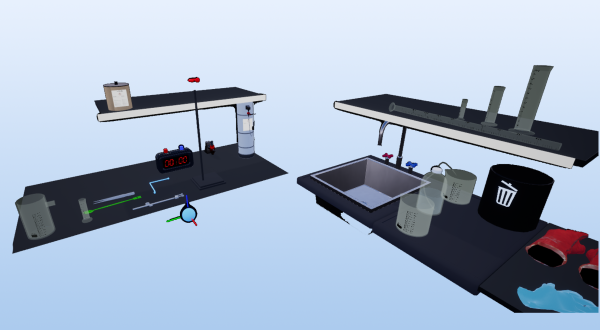
This experience is designed to teach methods for measuring the volume of different material states: liquid, solid, and gas, using specific techniques and equipment for each case. It makes it possible to understand the principles of measurement and the physical properties of matter through practical methods.
Part 1: Measure the volume of a liquid. This part demonstrates how to precisely measure the volume of a liquid using a graduated cylinder. The meniscus technique is essential to obtain precise reading because it considers the curvature that the liquid forms on the surface due to the surface tension forms.
Part 2: Measure the volume of a solid by movement of water. This method uses the principle of Archimedes, which stipulates that the volume of fluid moved is equal to the volume of the submerged object. By measuring overflowed water when a solid is immersed in a too full vase, you can determine the volume of the solid. It is a particularly useful technique for irregular solids that cannot be measured directly by a rule or a caliber.
Part 3: Measure the volume of gas. Measuring the volume of a gas uses a gas buret submerged in water, allowing gas to replace water in the buret. This method illustrates how gases can be contained, and their volume measured by moving another fluid. It depends on the atmospheric pressure and the capacity of the gas to occupy all the available space, in accordance with the laws of gas.
Educational Goals
Practice specific measurement methods: students learn to use different measuring instruments and correctly interpret the readings to obtain specific results.
Understanding the properties of matter: experience illustrates the fundamental physical properties of the different states of matter, such as the capacity of liquids to form a meniscus, the solidity of the solids which allows them to move water, and the expansibility of gas.
Apply physical principles: steps involve the application of physical principles, such as the principle of Archimedes for solids and gas laws to measure the volume of gases.
By combining theory and practice, this experience educates on basic measurement techniques in physics and chemistry, while strengthening understanding of the properties of matter in its different states.
Protocol
PART 1: Measuring the volume of a liquid
1) In the appropriate graduated cylinder, pour 70 mL of tap water.
2) Check the base of the meniscus of the graduated cylinder to confirm the volume.
PART 2: Measuring the volume of a solid using an overflow vessel
To measure the volume of a solid, we can use water displacement.
1) With tap water, fill a vase to overflow at its full capacity before spillage (500 mL). Let the excess water drain into the sink.
2) Replace the overflow vessel back to its initial position on the left side of the counter, right next to the 25 mL graduated cylinder (which will be positioned under the overflow opening of the overflow vessel).
3) Place five pieces of lead into the overflow vessel using pliers.
4) Using the overflow from the overflow vessel and the meniscus in the graduated cylinder, determine the volume of the solid.
PART 3: Measuring the volume of a gas
To measure the volume of gas, we can use a gas burette.
1) Fill a 1 L beaker with at least 800 mL of tap water.
2) Place the 1L beaker to the right of the stand.
3) Place a universal clamp above the center of the 1L beaker, in order to support the gas burette.
4) Fill the beaker with 250 mL of tap water.
5) Fill the gas burette with water from the 250mL beaker, then place a rubber stopper in it.
6) Attach the gas burette to the universal clamp upside down, so that the opening with the stopper is near the bottom of the 1L beaker.
7) Remove the rubber stopper (the tip of the burette must be immersed in the beaker).
8) If water flows out of the burette, it means there is not enough water in the beaker or the burette is too high. Repeat steps 4 to 7.
9) Place a plastic connector so that its J-shaped opening is under the opening of the gas burette.
10) Connect the blue hose from the gas cylinder to the connector.
11) Start the stopwatch.
12) Open the valve of the cylinder.
13) Let the gas burette fill halfway with gas.
14) Close the gas valve and read the volume on the gas burette.
15) Stop the stopwatch.
16) The results are also displayed graphically in the Results tab. / Volume vs. Time,
Anticipated Outcomes
This is a practical session to familiarize yourself with the use of the graduated cylinder, the overflow vessel, and the gas buret.
- One piece of Pb weighs 34.04g
- 5 pieces weigh 170.2g
- Pb has a density of 11.35 g/mL
- 5 pieces have a volume of 15 mL
- The gas is air.
Summary of Assignment by Grade Range
Grades 3-5 (Ages 8-10)
- Focus: Basic introduction to measurement techniques and understanding matter properties.
- Activities: Using graduated cylinders for liquids, simple water displacement for solids.
Grades 6-8 (Ages 11-13)
- Focus: Developing measurement skills and applying basic physical principles.
- Activities: Precision in using graduated cylinders, applying Archimedes’ principle, introduction to gas volume measurement.
Grades 9-12 (Ages 14-18)
- Focus: Mastering measurement techniques and understanding advanced physical principles.
- Activities: Advanced use of graduated cylinders, detailed application of Archimedes’ principle, precise gas volume measurement.
Laboratory essentials
Instruments
- Beaker (1000 ml – 250mL)
- Gaz buret
- Gaz connector
- Gaz tank
- Graduated cylinders (10 ml, 25 ml, 70 ml, 250 ml)
- Lab Stand & Clamps
- Overflow Vessel
- Tweezers
- Timer
- Stopper
Products
- Lead (Pb) pieces